Article and all photos by Joe Mock, BaseballParks.com
All rights reserved
My last visit to New Mexico’s largest city was to see a baseball game at Albuquerque Sports Stadium during the Dukes’ “lame duck” season in 2000. This time, I was in town to witness the first home game of Albuquerque’s new team, the Isotopes. It was also the inaugural contest in the completely rebuilt ballpark.
 |
| Here’s the very first pitch thrown at the completely rebuilt ballpark in Albuquerque on April 11, 2003. The Isotopes’ hurler was Nate Bump and the batter was Jeff Pickler of Oklahoma. |
The Preparation
On May 30, 2001, when the voters of New Mexico’s biggest city elected to rebuild Albuquerque Sports Stadium instead of constructing a ballpark at a new location (which most likely would’ve been downtown), they saved the taxpayers at least $5 million. Not only that, the plan took advantage of an enormous amount of parking, since the old ballpark was across the street from the University of New Mexico’s football stadium and the famous basketball arena known as “The Pit.”
But the timetable called for the entire facility to be designed and constructed in just 18 months. HOK, the architects behind such noteworthy achievements as Camden Yards and Coors Field, leapt headfirst into the assignment. They left practically nothing from the old facility — save the field itself and, to some extent, the dugouts and tunnels under the stands. Leaving the field in place is quite significant, because it would’ve cost about $2 million to lay down the 200,000 cubic yards of dirt necessary for a playing surface at a new location.
So the field is essentially the same, but the outfield fences, scoreboard, berm, seating bowl, exterior, press box and overhang are all brand new. And none of these things even resemble the old park.
  |
| On the left is a shot from the “drive-in” area taken during the stadium’s last season in 2000. On the right from roughly the same vantage point is the new 2003 model. Gee, not much similarity, is there? |
The Design
The rebuilt park is a thoroughly modern facility — with a touch a whimsy on the exterior. Whimsy? Yes, after all, the new team nickname comes from the minor-league franchise in the fictional town of Springfield where “The Simpsons” live. You see, in one episode, the team threatened to move to (gasp!) Albuquerque of all places! Homer Simpson came to the rescue, though, as he went on a hunger strike to protest the impending move of the team. The Springfield Isotopes stayed put.
Well, the tie-in of this “Simpsons” episode with New Mexico’s nuclear industry was just too tempting, so when the fans were asked to vote, the name Isotopes won in a landslide.
And because of the cartoon connection, the HOK folks decided that a dose of futuristic whimsy was called for in the stadium’s exterior. Not only are there panes of glass with some crazy colors, the whole structure seems to lean to one side. I give HOK a lot of credit for being different in this way — and it works.
  |
| A fanciful logo, colorful glass and a slightly slanted wall greet fans on opening night. In the main seating bowl behind home plate, you can see the two rows of stacked luxury boxes. |
The interior of the park is intelligently laid out, although there’s nothing earth-shattering about the design of the main seating bowl. HOK did decide to run the luxury suites in two rows so they are all in the infield, however, which probably makes them more sellable, but it also gives the structure somewhat of a top-heavy look.
In my opinion, though, there are two design elements that are simply splendid. First, the center-field fence is concave, and the ground rises up to meet the fence all around this indention. In one respect, this is like the center field “hill” in Houston’s Minute Maid Park. However, that hill rises to a point that makes the shape of the outfield almost square. In Albuquerque, the outfield fence in dead center field is actually closer to home plate than just to the right and left of that point, due to the concave shape of the fence. Frankly, I like this arrangement infinitely more than the gimmick-filled joke of an outfield fence in Minute Maid Park (with all of its ins and outs, a see-through area in front of the left-field bullpen and, worst of all, a flagpole that’s in play). Isotopes Park’s outfield is actually very attractive, while being totally different than at other stadiums.
  |
| Here’s a view of the center-field wall from right field. On the right, the wonderful berm offers some grass, some sidewalks and some ledges to sit on. |
The other wonderful aspect is “The Creamland Berm” beyond the right-field fence. Without a doubt, this is the most attractive and functional berm area I’ve ever seen at a ballpark — and lots of parks have sprouted these berms in recent years. Instead of being a smoothly sloped, grassy hill, this berm has areas which are paved and have ledges — so you don’t have to sit right on the grass. Also, the landscaping there is very nice.
While making my notes about this park at its inaugural night, I asked David Bearman, the talented, high-energy Media Relations Coordinator for the Isotopes, for his favorite aspect of the park. Without hesitation, he point out, “how open the park is. Open concourse, open seating area, open (press) booth. You can have a big crowd like tonight and it doesn’t feel crowded.” This feeling of openness carries over to the concourse at the rear of the main seating level, and you can indeed watch the action on the field while strolling to a concession stand. “I’ve been to Major League parks where the concourses aren’t as nice and wide open as here,” noted David.
And speaking of strolling, there is indeed a 360-degree concourse ringing the entire facility. In my mind, every well-designed ballpark should have this feature.
The Experience
The prices of the tickets are very reasonable for AAA baseball, ranging from $5 to sit on the wonderful berm to $10 for boxes. The parking is the best price that it can be: free!
If you approach the park from the outside behind home plate, the landscaping and fanciful exterior of the facility really jump out at you. The gates through which you enter are a wonderful cross-breeding of a Southwestern look with cartoons! Once inside, the fun on-field promotions and clever names of the food stands add to the family atmosphere. Even the logo of the team’s name and the cartoonish mascot “Orbit” are a hoot!
The setting of the park, as mentioned above, is not downtown Albuquerque, nor is it near the touristy (but still fun) wild-west Old Town area. It is located, though, where there is a wonderful view of the Sandia Mountains. This is one of the best ballpark views outside of Utah (where all three Minor League parks have spectacular views of the Wasatch Mountains).
The not-so-great element
As is the case with the ballpark in Frisco, Texas (which opened a week before this one), the worst element of the park is hardly a big deal. In this case, it’s the souvenir store. When I read that the Isotope’s logo was the runaway best-seller among all Minor League merchandise, I envisioned a huge store at the park with countless items showing the “A” with the protons flying around it. There is a store, but I’ve seen ones at Double-A parks that are larger, and I was disappointed with the selection of apparel, especially for kids.
But if that’s the worst I can say about Isotopes Park, then you can correctly conclude that this new ballpark is a real winner!